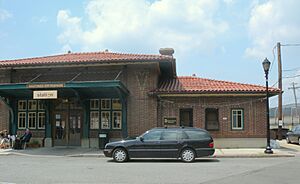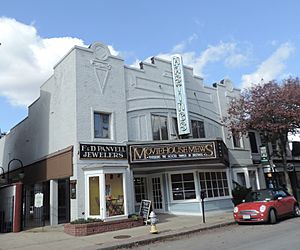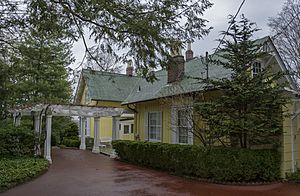Hastings-on-Hudson, New York facts for kids
Quick facts for kids
Hastings-on-Hudson, New York
|
||
|---|---|---|
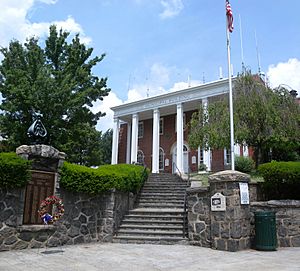
Municipal building
|
||
|
||
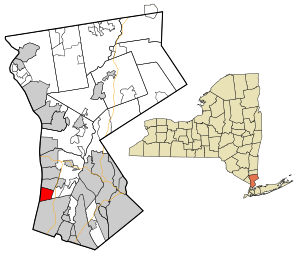
Location of Hastings-on-Hudson, New York
|
||
| Country | United States | |
| State | New York | |
| County | Westchester | |
| Town | Greenburgh | |
| Area | ||
| • Total | 2.92 sq mi (7.56 km2) | |
| • Land | 1.98 sq mi (5.13 km2) | |
| • Water | 0.94 sq mi (2.43 km2) | |
| Population
(2020)
|
||
| • Total | 8,590 | |
| • Density | 4,340.58/sq mi (1,675.90/km2) | |
| Time zone | UTC-5 (Eastern (EST)) | |
| • Summer (DST) | UTC-4 (EDT) | |
| ZIP codes |
10706
|
|
| Area code(s) | 914 | |
| FIPS code | 36-32710 | |
| Website | http://hastingsgov.org/ | |
Hastings-on-Hudson is a small village in Westchester County, New York. It is located in the southwestern part of the town of Greenburgh. This village is a suburb of New York City. It sits about 20 miles (32 km) north of midtown Manhattan. You can get there by train using the Metro-North Hudson Line.
To the north of Hastings-on-Hudson is the village of Dobbs Ferry. To the south is the city of Yonkers. East of the village are parts of Greenburgh that are not incorporated. In 2020, about 8,590 people lived here. The village is on U.S. Route 9, also known as "Broadway." It is also near the Saw Mill River Parkway.
Contents
History of Hastings-on-Hudson
The area where Hastings-on-Hudson and Dobbs Ferry are today was once home to the Weckquaesgeek people. They were an Algonquian tribe and called their community Wysquaqua. In the summer, they would camp near the Warburton Avenue Bridge. They fished, swam, and gathered oysters and clamshells. These shells were used to make wampum, which was a type of shell bead. On a flat area nearby, they grew corn and possibly tobacco.
Archaeologists have found many old tools and items. This suggests that the Weckquaesgeek people were very active where Factory Brook and Scheckler's Brook meet. This area is now behind the Cropsey Studio.
Early European Settlement (Pre-1920)
Around 1650, a Dutch carpenter named Frederick Philipse came to New Amsterdam. In 1682, Philipse traded with the Native Americans. He acquired the land that is now Dobbs Ferry and Hastings-on-Hudson. In 1693, the English King gave Philipse a large estate called the Manor of Philipsburg. Hastings-on-Hudson was part of this estate. Philipse divided the land into four farms. He then leased these farms to Dutch, English, and French Huguenot settlers.
During the American Revolution, the area of Hastings-on-Hudson was considered neutral ground. This meant it was between the fighting armies. However, it often became a "no-man's land." Both sides would raid the area. A small battle called the Battle of Edgar's Lane happened here. After the Revolution, the Philipses lost their land. They had supported King George III. The new American state took their lands and sold them. In 1785, four people bought the farms that make up Hastings-on-Hudson today. They were James DeClark, Jacobus Dyckman, George Fisher, and Peter Post.
Around this time, Westchester County was divided into towns. Hastings-on-Hudson became part of the town of Greenburgh. The village officially became a village in 1879. Its name changed from Hastings-Upon-Hudson to Hastings-on-Hudson.
Stone quarrying was the first big industry in Hastings-on-Hudson. From 1865 to 1871, many Scottish and Irish workers dug out large amounts of dolomitic marble. This white marble came from a Westchester marble quarry. A special railroad carried the marble down to the quarry dock. There, skilled stonecutters shaped it. Then, it was loaded onto ships. These ships took the marble to cities like New York and Charleston, South Carolina.
By the 1880s, a company called Hastings Pavement made hexagonal paving blocks. These blocks were used in famous parks like Central Park and Prospect Park in Brooklyn. Between 1895 and 1900, Hastings Pavement made 10 million such blocks. They shipped them across the United States and to Canada, Brazil, and England.
By 1891, the National Conduit and Cable Company started operating on the waterfront. They made cables for utility companies in the U.S. and other countries. In 1912, there was a strike at this company. Two workers and two bystanders died during the conflict. Similar worker problems happened in 1916. During that time, the village was under a kind of house arrest.
During World War I, 200 National Guardsmen were stationed in Hastings-on-Hudson. This was to protect the National Conduit plant. Also, a chemical plant opened by Frederick G. Zinsser made a wood alcohol called Hastings Spirits. This plant was important for making ammunition during the war.
Recent History (1920-Present)
The Anaconda Copper Company took over National Conduit in 1929. A few years later, they also bought the Hastings Pavement property. By the end of World War II, Anaconda owned most of the industrial area along the waterfront. Anaconda closed its Hastings-on-Hudson plant in 1975. This ended a century of heavy industry in the village.
A hospital called Hillside-on-Hastings opened in 1926. It moved to Glen Oaks, Queens, in 1941.
Billie Burke, an actress famous for playing the "Good Witch" in The Wizard of Oz, lived in Hastings-on-Hudson. She left her property to the school district. The district still owns it and uses it for sports.
Benjamin Franklin Goodrich bought a small business called Hudson River Rubber Company in Hastings-on-Hudson. He later moved the business to Akron, Ohio. This company became the famous Goodrich Corporation.
Children's Village is a place for children in difficult situations. It is in nearby Dobbs Ferry. In 1986, Children's Village sold about 50 acres (200,000 m²) of its land in Hastings-on-Hudson to a developer. The developer planned to build nearly 100 homes. This would have caused a lot of traffic near Hillside Elementary School. Local residents formed a group called "Save Hillside Woods." They raised almost $800,000. Because of a stock market crash in 1987, the village was able to buy this land. They used the money raised and a bond to expand and care for Hillside Woods.
The Jasper F. Cropsey House and Studio and Hastings Prototype House are important historic places. They are listed on the National Register of Historic Places. The John William Draper House is also a very important historical site.
Geography and Location
Hastings-on-Hudson is located at 40°59′28″N 73°52′27″W / 40.99111°N 73.87417°W. It is in an area with hills, right on the Hudson River. Across the river, you can see the Palisades cliffs. The village is north of the city of Yonkers. The Hudson River is to the west, and the Saw Mill River is to the east. From areas facing the Hudson River, you can see the Palisades, Manhattan to the south, and the Mario Cuomo Bridge to the north.
The United States Census Bureau says the village covers about 2.9 square miles (7.5 km²). About 2.0 square miles (5.2 km²) of this is land. The other 0.9 square miles (2.3 km²), or about 32.65%, is water.
Several small streams that flow into the Hudson River are in the village. Scheckler's Brook starts in Hillside Woods. Factory Brook begins from a spring in the southern part of the Burke Estate. These two streams meet behind the Cropsey Studio, west of the Aqueduct Trail.
Getting Around Hastings-on-Hudson
Even though it's a suburb of New York City, Hastings-on-Hudson has good public transportation. You can take a commuter train from the Hastings-on-Hudson railway station. This station is on the Metro-North Railroad's Hudson Line. It goes to Grand Central Terminal in New York City. You can also go north to Croton-on-Hudson and Poughkeepsie. If you want to take an Amtrak train, you can transfer three stops south at the Yonkers railway station.
There are also several bus routes run by the Bee-Line Bus System. These buses connect Hastings-on-Hudson to other places in Westchester and parts of the Bronx.
The Saw Mill River Parkway has exits in Hastings-on-Hudson. US Route 9 also runs through the village. It is known as Broadway here.
Population and People
| Historical population | |||
|---|---|---|---|
| Census | Pop. | %± | |
| 1880 | 1,290 | — | |
| 1890 | 1,466 | 13.6% | |
| 1900 | 2,002 | 36.6% | |
| 1910 | 4,552 | 127.4% | |
| 1920 | 5,526 | 21.4% | |
| 1930 | 7,097 | 28.4% | |
| 1940 | 7,057 | −0.6% | |
| 1950 | 7,565 | 7.2% | |
| 1960 | 8,979 | 18.7% | |
| 1970 | 9,479 | 5.6% | |
| 1980 | 8,573 | −9.6% | |
| 1990 | 8,000 | −6.7% | |
| 2000 | 7,648 | −4.4% | |
| 2010 | 7,849 | 2.6% | |
| 2020 | 8,590 | 9.4% | |
| U.S. Decennial Census | |||
In 2020, there were 8,590 people living in Hastings-on-Hudson. The village has about 4,020 people per square mile (1,552 per km²). Most homes were occupied.
Most people in the village are White (86.8%). There are also people who are African American (2.9%) and Asian (5.2%). About 2.5% of the population are from two or more races. About 6.6% of the population are Hispanic or Latino.
In 2020, the average household income in the village was $139,879. The per capita income (income per person) was $79,190. Only a small number of families (2.9%) and people (2.5%) lived below the poverty line.
In 2000, about 33.8% of households had children under 18 living with them. Most households (57.0%) were married couples. The average household had 2.47 people, and the average family had 3.05 people.
In 2000, 25.0% of the population was under 18. About 15.5% were 65 or older. The average age was 42 years.
Education in Hastings-on-Hudson
Hastings-on-Hudson is part of the Hastings-on-Hudson Union Free School District. The village has three public schools:
- Hillside Elementary School
- Farragut Middle School
- Hastings High School
All three of these schools have received the National Blue Ribbon Award. This award recognizes schools for their excellent performance.
The Greenburgh-Graham Union Free School District also has a special needs school facility in Hastings.
Fun Things to Do and See

Hastings-on-Hudson is known as one of the "Rivertowns" in New York. These towns are seen as less suburban and more cultural. They are popular for their unique feel and lifestyle.
Here are some attractions and places for recreation in Hastings-on-Hudson:
- Chemka Pool: A community outdoor swimming pool near Hillside Woods.
- Hillside Woods: A large wooded area with trails for hiking.
- Linear Parks:
- The Old Croton Aqueduct Trailway: A state park that runs north-south.
- The South County Trailway: A county park that also runs north-south.
- Sugar Pond: A small pond in the Riverview Manor part of Hillside Woods. You can go ice skating there in the winter.
- Playing Fields: Many fields for sports, including the Burke Estate, Zinsser Park, Reynolds Field, and Uniontown Field.
- Downtown Hastings-on-Hudson: A lively area with shops and restaurants.
- Ever Rest: The home and studio of the famous painter Jasper Cropsey (1823–1900). It is a historic site.
- Public Library: A great place to read and learn.
- Farmer's Market: Held on Saturdays (outdoors from June to November, indoors twice a month from December to May).
- VFW Building: Has a dance studio and a karate school.
- Hastings High School: Presents theatre productions and other shows.
- "Museum of the Streets": A walking tour with historic markers. The Hastings Historical Society maintains it.
- MacEachron Waterfront Park: A new outdoor concert series started here in 2018.
- River Spirit Music and Arts Festival: The village's annual event, held at Draper Park on the second Saturday of September.
Famous People from Hastings-on-Hudson
- Steve Addabbo, Grammy winner
- Marco Arment, creator of Instapaper and co-founder of Tumblr
- Edoardo Ballerini, actor, audiobook narrator
- Helen Barolini, author
- Michael Brecker, jazz saxophonist and composer
- Billie Burke, actress (the "Good Witch" in The Wizard of Oz)
- Daniel Callahan, medical ethicist
- Kenneth B. Clark and Mamie Phipps Clark, influential civil rights pioneers and psychologists
- Stephen Collins, actor
- Jasper Francis Cropsey, painter
- William Daley, ceramist, professor
- Albert Dekker, actor
- Crescent Dragonwagon, novelist, children's book writer, cookbook author
- Daniel Draper, meteorologist
- Dorothy Catherine Draper, educator and chemist
- Henry Draper, astronomer; first to discover that oxygen is present in the sun
- John W. Draper, first president of American Chemical Society
- Adrian Ettlinger, inventor and engineer
- Michael Ettlinger, policy and political advisor, educator
- David Farragut, American Civil War Union Navy admiral
- Martin Gardner, author of "Mathematical Games" column in Scientific American
- Giuseppe Garibaldi, key figure in Italian unification
- Marcia Mitzman Gaven, actress and Tony Award nominee
- Willard Gaylin, psychiatrist and medical ethicist
- Seth Godin, entrepreneur, author and public speaker
- Benjamin Franklin Goodrich, founder of Goodrich Corporation
- Zack O'Malley Greenburg, author and former child actor
- Harry Hillman, Olympic gold medalist in track and field
- Lewis Hine, photographer
- Jack Houghteling, novelist
- Roger Howarth, actor
- James Howe, children's book author, author of Bunnicula
- James Kaplan, author
- Ricki Lake, actress and television talk show host
- John Lavachielli, actor
- David Leonhardt, Pulitzer Prize-winning columnist for The New York Times
- Barron H. Lerner, internist, medical historian and ethicist, professor of medicine
- Jacques Lipchitz, sculptor
- Steven Lysak, Olympic gold medalist in canoeing
- Ali Marpet, American football player in the NFL
- Antonia Maury, astronomer
- Robert Meeropol, son of Ethel and Julius Rosenberg
- Robert C. Merton, Nobel Memorial Prize in Economics winner
- Robert K. Merton, sociologist
- Frank Morgan, character actor (title character in The Wizard of Oz)
- George Newall, co-creator, composer, executive producer for School House Rock
- Adolph S. Ochs, The New York Times publisher
- Keith Olbermann, news anchor, commentator and radio sportscaster
- Jan Owen, book artist
- John Patitucci, jazz bass player
- Edmund Phelps, Nobel Memorial Prize in Economics winner
- Leo James Rainwater, Nobel Prize-winning physicist
- Molly Ringwald, actress
- John Riordan, Bell Labs mathematician
- Coco Rocha, model
- J.T. Rogers, playwright
- John Saunders, ESPN
- Alan Schneider, Broadway director
- Cathy Seibel, United States federal judge
- William Shatner, actor
- Richmond Shreve, architect (Empire State Building)
- Charles Siebert, actor/director
- Jerry Silverman, guitarist, folk singer, teacher, publisher
- Gary Smulyan, jazz baritone saxophonist
- André Leon Talley, editor-at-large of American Vogue
- Max Theiler, Nobel Prize laureate
- John Bartholomew Tucker, radio and television personality, author
- Howard Van Hyning, percussionist with the New York City Opera
- William Vickrey, Nobel Memorial Prize in Economics winner
- Charles Webb, novelist (The Graduate)
- Phideaux Xavier, progressive rock musician
- Ed Young, children's book author and illustrator
- Florenz Ziegfeld, Broadway producer (the Ziegfeld Follies)
- Charlotte Zolotow, children's book author and editor
- Maurice Zolotow, Hollywood biographer
See also
 In Spanish: Hastings-on-Hudson para niños
In Spanish: Hastings-on-Hudson para niños




